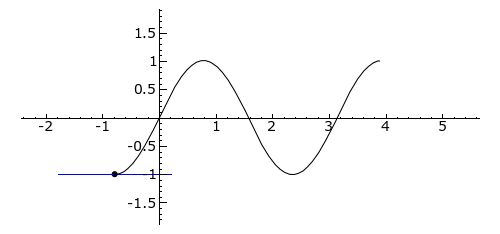"Inflection points and turning points - since you asked
May 13, 2009 3:18am
The President of the European Central Bank, Jean-Claude Trichet, did not say that the recession was bottoming out. He said that it had reached an ‘inflection point’: “As far as growth is concerned, we’re around the inflection point in the cycle, that’s the sentiment,…” . Unlike the gormless arts students, limp-minded lawyers and woolly social scientists that dominate British and American economic policy making, President Trichet actually knows and understands mathematics. An inflection point is not a turning point.
Assume the cycle, C, can be represented as a twice continuously differentiable function of time, t, say
C = f(t)
What President Trichet was referring to was that, since the last quarter of 2008 or thereabouts, real economic activity had been declining in the Euro Area, that is, f’<0 or the first derivative (nothing to do with CDS) of activity with respect to time had been negative. Not only that, but it had been declining at an increasing rate, that is, f”<>. The reference to the inflection point means that President Trichet now believes that activity, while still declining, is no longer declining at an increasing rate but instead is now falling at a decreasing rate. That is, today, f”‘ > 0, passing through f”= 0 (the inflection point) along the way.
An inflection point is a point on a curve at which the curvature changes sign from concave downwards (upwards) to concave upwards (downwards), or, equivalently in the case under consideration, where the second derivative changes sign (f”(t) = 0 is not in general a sufficient condition for t to be a point of inflection. In addition, the lowest-order non-zero derivative must be of odd order (first, third, fifth, etc.). If the lowest-order non-zero derivative is of even order, the point is not a point of inflection. So if f” changes sign and f” has the same sign ‘before’ and ‘after’, we have a point of inflection. That’s why an inflection point is not a turning point.
A turning point is where the first derivative changes sign. In our current cyclical circumstances, we are all (the moving graph works with Firefox, I cannot get it to work with Internet Exporer - one more reason for switching to Firefox).
 Plot of f(x) = sin(2x) from − π / 4 to 5 * π / 4; note f’s second derivative is f”(x) = − 4 * sin(2x). Tangent is blue where curve is concave up (above its own tangent), green where concave down (below its tangent), and red at inflection points: 0, π / 2 and π.
Plot of f(x) = sin(2x) from − π / 4 to 5 * π / 4; note f’s second derivative is f”(x) = − 4 * sin(2x). Tangent is blue where curve is concave up (above its own tangent), green where concave down (below its tangent), and red at inflection points: 0, π / 2 and π.
President Trichet’s statement that the cycle is at an inflection point is therefore quite consistent with the IMF’s forecast that real economic activity in the Euro Area will continue to decline for this year and much of the next. Both Trichet and the IMF could of course be wrong, but it helps to be clear about what he actually said."
Me:"The reference to the inflection point means that President Trichet now believes that activity, while still declining, is no longer declining at an increasing rate but instead is now falling at a decreasing rate"
I love the moving graph, but why couldn't he have just said that since we're all innumerate, or whatever the term is? By the way, he said, "we’re around the inflection point in the cycle". What color is "around the inflection point"?







































No comments:
Post a Comment